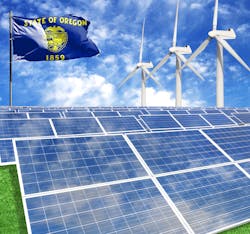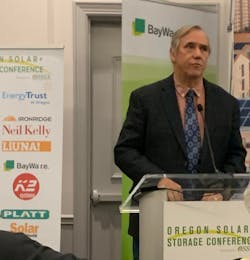US Inflation Reduction Act spurs tribes to seek microgrid partners
Tribes are eager to partner with microgrid and solar developers now that the “game-changing” Inflation Reduction Act (IRA) allows them to receive direct payments for the tax credits provided under the act, said tribal representatives at the Oregon Solar and Storage Conference held in Portland, Oregon, last week.
They spoke during a panel discussion about how the IRA has opened up opportunities for developers to partner with tribes.
Tribal representatives stressed that when they partner with developers, they’re interested in owning shares in projects and want developers to be sensitive to cultural and environmental issues important to their communities.
“Early engagement in these projects should be developed with tribes, preferably with a contact that works for the tribe, a trusted messenger,” said Cathy Ehli, general manager of Warm Springs Power and Water Enterprises, which manages the Warm Springs Reservation’s interest in the Pelton/Round Butte Hydroelectric Project located on the Deschutes River in central Oregon. “Be open minded about how you can navigate working with tribes,” she said.
New ability to monetize tax credits
The IRA is beneficial to tribes because as tax-exempt entities they have been unable to monetize the current tax credits, but they will have the ability to do so under the IRA.
The legislation provides various ways to monetize tax credits. Tax-exempt entities like cities, states and tribes can receive direct payment equal to the amount of the credit. The IRA also allows for the transfer of credits from one taxpayer to another.
In addition, the IRA now allows stand-alone storage — as opposed to storage paired with solar — to qualify for the investment tax credit (ITC).
“I think this is a game changer and opportunity for tribes,” said Maggie Tallmadge, senior development manager at Navajo Power, a public benefit corporation that develops utility-scale clean energy on tribal lands. “Tribes need to be seen as partners in the development process." Tribes can now build capacity and own shares in projects, she added.
Not only will tribes benefit from the direct pay provisions of the ITC, but those located within environmental justice and energy communities could see a boost to the ITC above 30% under the provisions of the legislation.
Sen. Merkley: Seize the opportunity
Merkley also said that it’s important for policymakers to address renewable energy permitting challenges.
In addition, he urged conference attendees to “seize the opportunity” of the 30% ITC.
When asked if the IRA would be undone if Republicans take control of Congress, Merkley said, “It’s harder to undo something than to do something.”
Microgrids solve many problems
During the panel discussion about tribes, Tallmadge said that tribes have been calling for microgrids to solve numerous challenges.
The remote areas that are home to tribal entities are often the last to be re-energized after an outage, said Tallmadge. Outages can last seven to 10 days.
“This is hard for elders, health care, education and enterprises,” she said, adding that microgrids can boost resilience and protect public health.
Second, tribes often pay high energy prices. They’re often located in rural electric cooperative territory and don’t always have representation on these cooperatives’ boards. “Without representation, tribes have a really unfair disadvantage in terms of what they’re charged. Tribes want to stand alone and control their energy use,” she added.
Achieving energy sovereignty is a “huge movement” among tribes, Tallmadge said.
“We hear constantly from tribes about microgrids. We look for partners to help us meet these needs,” said Tallmadge.
Warm Springs Power and Water Enterprises is “open for business,” said Ehli. The Warm Springs Reservation has solar sites, and the organization is ready to take a step into renewables with the help of developers, she said.
Visiting with community members, Ehli has been impressed by the community’s interest in taking advantage of the opportunities provided by the IRA.
“Folks are engaged and eager to see these opportunities come to fruition. The timing is right,” said Ehli.
Robert Lothrop, manager at the Columbia River Inter-Tribal Fish Commission, said that renewable energy can help take the pressure off the Columbia River dams to produce energy. Less pressure on the river will help address the challenge of declining salmon runs in the Columbia River, he added.
Support from California
Meanwhile, the California Energy Commission (CEC) has awarded a $31 million grant for a long-duration energy storage system that will provide backup power for the Viejas Tribe of Kumeyaay Indians and help provide grid reliability in the event of an emergency.
The CEC awarded the grant to Indian Energy, a Native American-owned microgrid developer that will build the project for the tribe.
The grant is one of the largest state grants ever given to benefit a tribal government. It was awarded as part of the state’s new $140 million Long-Duration Energy Storage Program, which is part of Gov. Gavin Newsom’s commitment to fight climate change.
The aim of the project is to demonstrate the potential of long-duration energy storage.
The 60-MWh long-duration system will provide backup to the community during outages and will allow the tribe to island from the grid when the grid needs power.
Align with tribal goals
Whether renewable energy and microgrids provide backup to native communities, energy sovereignty, an improved environment or lower costs, it’s important for developers planning projects to attend to tribes’ needs and goals, said Lothrop of the Columbia River Inter-Tribal Fish Commission.
“The message is ‘Look at your projects holistically and try to establish tribal goals,’” he said.
Do you have a story to tell about microgrids? Microgrid Knowledge is seeking speaker applications through Dec. 21, 2022 for Microgrid 2023: Lights On, which will be held May 16-17, 2023 in Anaheim, California.
About the Author
Lisa Cohn
Contributing Editor
I focus on the West Coast and Midwest. Email me at [email protected]
I’ve been writing about energy for more than 20 years, and my stories have appeared in EnergyBiz, SNL Financial, Mother Earth News, Natural Home Magazine, Horizon Air Magazine, Oregon Business, Open Spaces, the Portland Tribune, The Oregonian, Renewable Energy World, Windpower Monthly and other publications. I’m also a former stringer for the Platts/McGraw-Hill energy publications. I began my career covering energy and environment for The Cape Cod Times, where Elisa Wood also was a reporter. I’ve received numerous writing awards from national, regional and local organizations, including Pacific Northwest Writers Association, Willamette Writers, Associated Oregon Industries, and the Voice of Youth Advocates. I first became interested in energy as a student at Wesleyan University, Middletown, Connecticut, where I helped design and build a solar house.
Twitter: @LisaECohn
Linkedin: LisaEllenCohn
Facebook: Energy Efficiency Markets


